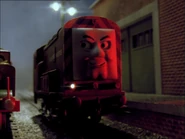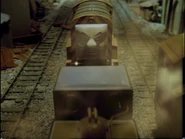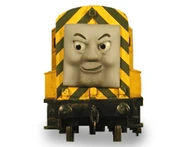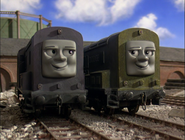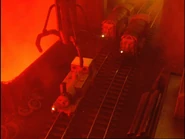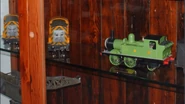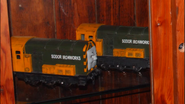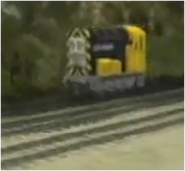| Line 16: | Line 16: | ||
==Behind the Scenes== |
==Behind the Scenes== |
||
===Gauge 1 Model=== |
===Gauge 1 Model=== |
||
| − | 'Arry and Bert's models were designed to run on gauge 1 track. They were built out of molds of [[Diesel]]'s model. Their buffers were made by [[Tenmille]] |
+ | 'Arry and Bert's models were designed to run on gauge 1 track. They were built out of molds of [[Diesel]]'s model. Their buffers were made by [[Tenmille]]. The chassis' were constructed from scratch (CNC). They were powered by electricity from the track via the pickups on the metal wheels. |
Twelve facial expressions were sculpted for both 'Arry and Bert. The faces were first sculpted in clay, and from that resin casts were made using a silicone mold. One of Bert's facemasks is owned by Twitter user [https://twitter.com/TomsProps TomsProps]. |
Twelve facial expressions were sculpted for both 'Arry and Bert. The faces were first sculpted in clay, and from that resin casts were made using a silicone mold. One of Bert's facemasks is owned by Twitter user [https://twitter.com/TomsProps TomsProps]. |
||
| − | |||
| − | The chassis' were constructed from scratch (CNC). They were powered by electricity from the track via the pickups on the metal wheels. |
||
The eye mechanism had two servos, one for up and down movement and one for left and right movement. The up/down servo was attached to the body. The left/right servo had a rod attached to the arm, which connected to a bracket. The eye balls were coupled to the bracket, and locked in by the face-plate, so whenever the servos were powered, the eye balls would move however the crew member desired. |
The eye mechanism had two servos, one for up and down movement and one for left and right movement. The up/down servo was attached to the body. The left/right servo had a rod attached to the arm, which connected to a bracket. The eye balls were coupled to the bracket, and locked in by the face-plate, so whenever the servos were powered, the eye balls would move however the crew member desired. |
||
| Line 30: | Line 28: | ||
File:IronArryFront.png |
File:IronArryFront.png |
||
File:IronBertFront.png |
File:IronBertFront.png |
||
| + | File:MiddleEngine9.png|'Arry and Bert's sly face that only appeared between the sixth and [[Series 9|ninth series]], excluding the [[Series 8|eighth series]] and [[Calling All Engines!]] (2002-2005) |
||
| ⚫ | |||
| + | File:Percy'sNewWhistle12.png|'Arry and Bert's smug face that only appeared between the eighth series and [[The Great Discovery]], excluding the tenth series (2004-2008) |
||
| − | File:'Arry&Bert'sFacemasks.png |
||
| ⚫ | |||
| + | File:'Arry&Bert'sFacemasks.png|'Arry and Bert's complete face mask set during production of the sixth series (2002) |
||
</gallery> |
</gallery> |
||
Revision as of 01:38, 30 March 2020

|
Background Information
Television Series
'Arry and Bert are fictional standard gauge twin diesel locomotives created by Britt Allcroft and David Mitton. They work on the North Western Railway. Despite being twins the two are not quite identical: Bert has more stubble.
In 1998, 'Arry and Bert made their debut in the fifth series of Thomas the Tank Engine and Friends in the episode, Stepney Gets Lost.
After being absent in the tenth series, 'Arry and Bert returned to the series in the following series.
When the show transitioned into full CGI in 2009, 'Arry and Bert were absent for a year and later returned in the fourteenth series.
From their return in 2010 until 2011, Kerry Shale provided the voices for 'Arry and Bert in both the British English and American English dubs of the series. In 2012, William Hope took over the role of Bert, leaving the role of 'Arry to Kerry Shale.
'Arry and Bert are based on the BR class 08.
Behind the Scenes
Gauge 1 Model
'Arry and Bert's models were designed to run on gauge 1 track. They were built out of molds of Diesel's model. Their buffers were made by Tenmille. The chassis' were constructed from scratch (CNC). They were powered by electricity from the track via the pickups on the metal wheels.
Twelve facial expressions were sculpted for both 'Arry and Bert. The faces were first sculpted in clay, and from that resin casts were made using a silicone mold. One of Bert's facemasks is owned by Twitter user TomsProps.
The eye mechanism had two servos, one for up and down movement and one for left and right movement. The up/down servo was attached to the body. The left/right servo had a rod attached to the arm, which connected to a bracket. The eye balls were coupled to the bracket, and locked in by the face-plate, so whenever the servos were powered, the eye balls would move however the crew member desired.
In Thomas and the Magic Railroad 'Arry and Bert's models were repainted to create the characters Splatter and Dodge. After the events of the film, the models were later reverted back to 'Arry and Bert.
In the episode, Stepney Gets Lost, 'Arry and Bert were seen with lamps. These were powered by a hidden battery pack.
The twelfth series marked the beginning of the show's transition into CGI and the characters' faces were animated through CGI with the aid of motion capture animation. The physical models' molded faces were replaced by white targets with triangles to fix a computer-animated face in post-production. 'Arry and Bert's resin faces were only used in background shots. In addition, their faces reduced in size.
'Arry and Bert have had modifications throughout the model era. These include:
- Series 6:
- Their side rods change from silver to black.
- The text, "Sodor Ironworks", on their sides became bigger.
- Their models were significantly less weathered than the previous series.
- Series 12:
- Their faces become smaller still.
'Arry and Bert's models used to be on display in Canada at Nitrogen Studios.
Close-up model
Close-up shots of 'Arry and Bert's cabs were required for scenes in where they had to interact with close-up scale figures. Only one model was ever built which was not complete and only portions of the cab were built. 'Arry and Bert's close-up model only appeared in the Calling All Engines! Learning Segments, Which Things are the Same?.
CGI Model
In 2009, the series introduced Computer-Generated Imagery (CGI) as a replacement for the show's long-standing live-action models. 'Arry and Bert were recreated from scratch in CGI by Nitrogen Studios. However, test footage was created by Stardust Pictures as they recreated scenes from Thomas and the Stinky Cheese. Their models were "hand-sculpted" in Maya, a 3D animation and modeling software. Photographs of 'Arry and Bert's Gauge 1 models were used for reference. According to Greg Tiernan, every detail of the original television series models for each character is carefully reproduced in the CGI model. The models are subjected to many rounds of review before they are submitted to HiT Entertainment for final input and approval.
'Arry and Bert have had modifications throughout the CGI series. These include:
- Series 14:
- Their faces went back to their season 5 size.
- Series 18:
- They each gained a tail-lamp.
- They gained new horn sounds.
Voice Actors
'Arry
Bert
|

